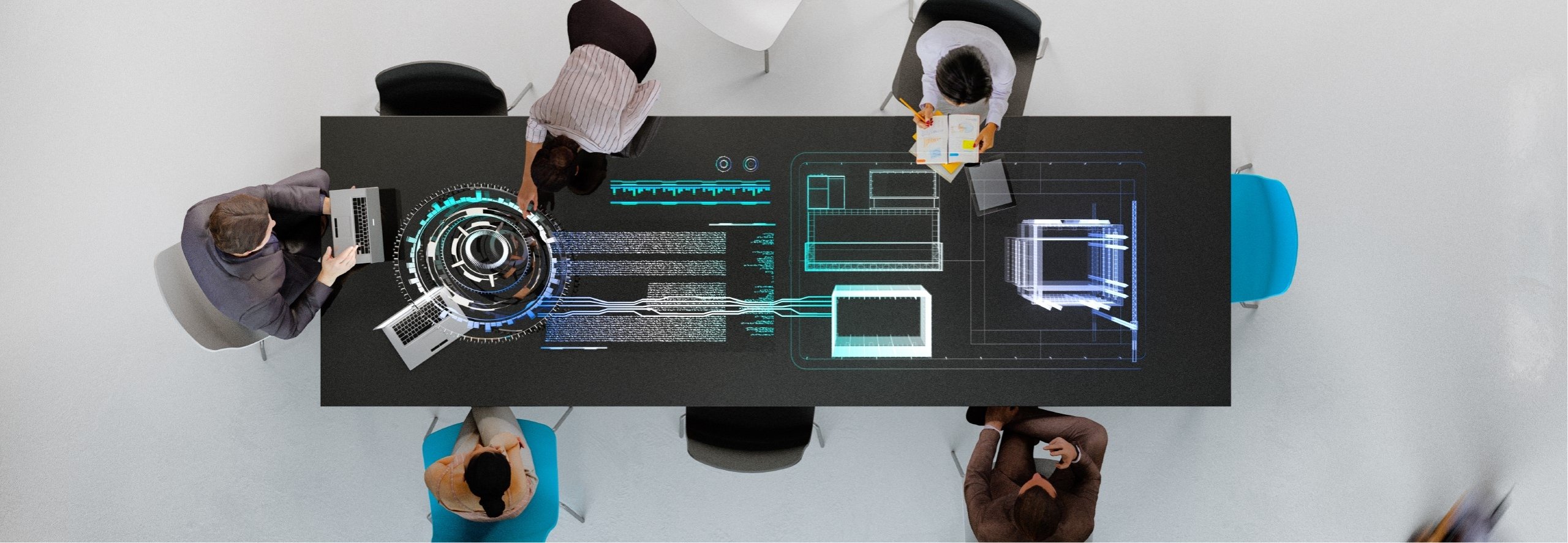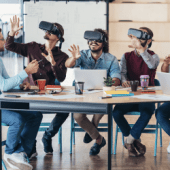Protiviti’s Fran Maxwell visits the workplace of 2035
IN BRIEF
- The pandemic has shown organizational leaders what is possible, while also offering them the rare opportunity to ask what else is possible.
- The office of the future will be designed and managed for the care and feeding of the corporate culture.
- Organizational leaders should start thinking about and investing in upskilling programs now to get employees proficient in automation, AI and quantum computing.
For more than a century, science fiction has produced tantalizing, eerily accurate previews of the future.
Video calls appeared in the 1968 movie 2001: A Space Odyssey, not long after Ian Fleming (creator of James Bond) wrote about a flying car. The Jetsons enjoyed 3D-printed meals, and Star Trek communicators provided an early use case for flip phones. Ray Bradbury described air pods in the 1940s, Mark Twain once wrote about something that sounds more than a little like the Internet, and Mary Shelley foretold organ transplants in the early 19th Century.
During the past two pandemic years, reality has delivered similarly enticing glimpses of possible futures across many realms, including a vivid preview of the workplace of the future. While the pandemic clearly reconfigured where we work, COVID-19 challenges also accelerated pivotal trends concerning how and when we work. All three dimensions will look markedly different in the workplace of 2035.
Where, when and how?
The pandemic showed organizational leaders what is possible. Without the imposition of social distancing protocols and the threat of business closures, we might not have discovered that large, complex organizations can execute a massive workforce transformation so nimbly. The remote work mobilization and the thousands of related adjustments and insights it generated provide leaders with a rare opportunity to leverage those hard-earned lessons by asking what else is possible.
During the next several years, we will continue to focus on where work is performed amid shifting employee preferences, a long-term talent crunch and the pandemic’s uncertain wake. As we iron out a new approach based on some combination of in-person, remote and hybrid working models, the role of the office is quietly transforming.
We already see some companies and industries reimagining and restructuring the physical office to foster meaningful workforce connections, collaborations and celebrations. The office of the future will be designed and managed for the care and feeding of the corporate culture. Leading organizations already are implementing rotating schedules so that different teams and groups take turns coming together periodically in configurable, shared workspaces.
In addition, during the past two years, large swaths of the workforce experienced the newfound ability to choose when they work. Suddenly, remote professionals with young children at home took care of more business later in the evening and in the wee hours, for example. Others learned how to align working hours with their circadian rhythms to elevate performance and reduce stress. Some workers logged too many hours and experienced burnout.
How and when work are performed are also being reimagined. The current talent crunch has intensified the use of the contingent workforce while hastening the adoption of advanced technologies, such as artificial intelligence (AI) and machine learning, that help organizations produce more and better work with fewer human resources.
Leaders and direct managers must respond to these opportunities and risks — and many more like them. When it comes to the adoption of advanced technologies, for example, we see leaders clarifying their messages to the workforce by pinpointing the value employees gain from automation and AI skills — and the role that personal development plays in deploying the organization’s global talent footprint more efficiently and effectively.
Five aspects of the future workplace
In 1964, The New York Times enlisted Isaac Asimov, one of the world’s most renowned sci-fi authors, to mark New York’s World Fair by imagining what the World’s Fair of 2014 would offer five decades later.
“Much effort will be put into the designing of vehicles with ‘Robot-brains’ — vehicles that can be set for particular destinations and that will then proceed there without interference by the slow reflexes of a human driver,” Asimov wrote. “I suspect one of the major attractions of the 2014 fair will be rides on small roboticized cars which will maneuver in crowds at the two-foot level, neatly and automatically avoiding each other.”
That prognostication wasn’t far off. As far as how our workplaces will look in 2035, I don’t know for certain, but — to quote Asimov from the aforementioned New York Times article — “I can guess”:
1. Offices are not for working
At least not in the conventional sense. Companies deploy highly configurable office real estate assets to conduct a range of activities designed to build teams, spark connections and innovations, strengthen retention, and enhance the resilience and value of their organizational cultures.
2. The line between upskilling and retention has blurred
Actually, organizational leaders should start thinking about upskilling programs and retention strategies simultaneously right now. We know upskilling is needed today to get employees proficient in automation in all its forms, AI and quantum computing (and in other yet-to-emerge technological advancements tomorrow). Without sufficient, commensurate attention to retention, employees will hop to better-paying competitors after their organization invests in their upskilling.
3. Employee experience is a competitive differentiator
Mapped to align with the customer experience, the employee experience reflects the organization’s employee value proposition and addresses the unique and, at times, oppositional needs and expectations of different generational segments and sub-segments.
4. The contingent workforce is part of the culture
Rather than relegating contingent workers to discrete projects and largely task-based assignments, organizations leverage this labor source to achieve more strategic returns, including the development of new capabilities. A new mindset also pervades as organizational and HR leaders invest more thought and effort in framing and supporting how contingent workers are part of the organizational culture.
5. Direct managers are rock stars
Direct managers (who oversee other employees and operations of a business) operate as organizational ambassadors and stewards of the culture given their day-to-day influence on the employee experience. They are fully aligned with a positive, collaborative tone set at the top.
Of course, predictions are difficult. The underground suburban houses, moon colonies and orbiting solar power stations Asimov predicted in 1964 would not be featured in a 2022 World’s Fair. Yet, Asimov also wrote that the 2014 world “will have few routine jobs … that cannot be done better by some machine than by any human being.” The trick in 2035 will be finding, keeping, fulfilling and continually developing human beings who can use those machines to optimize both the customer experience and their own.
Without sufficient, commensurate attention to retention, employees will hop to better-paying competitors after their organization invests in their upskilling.




























